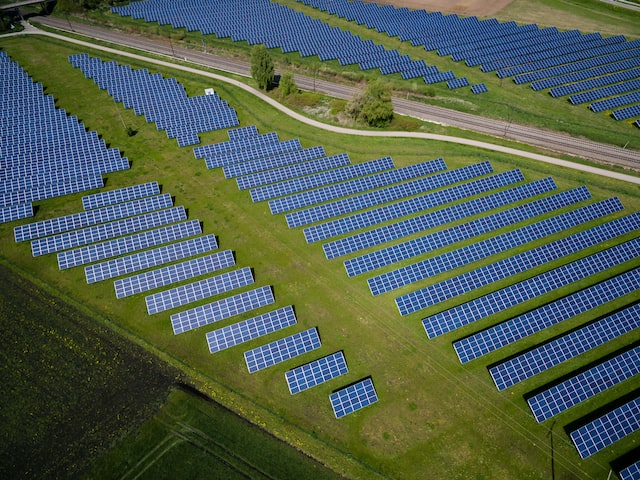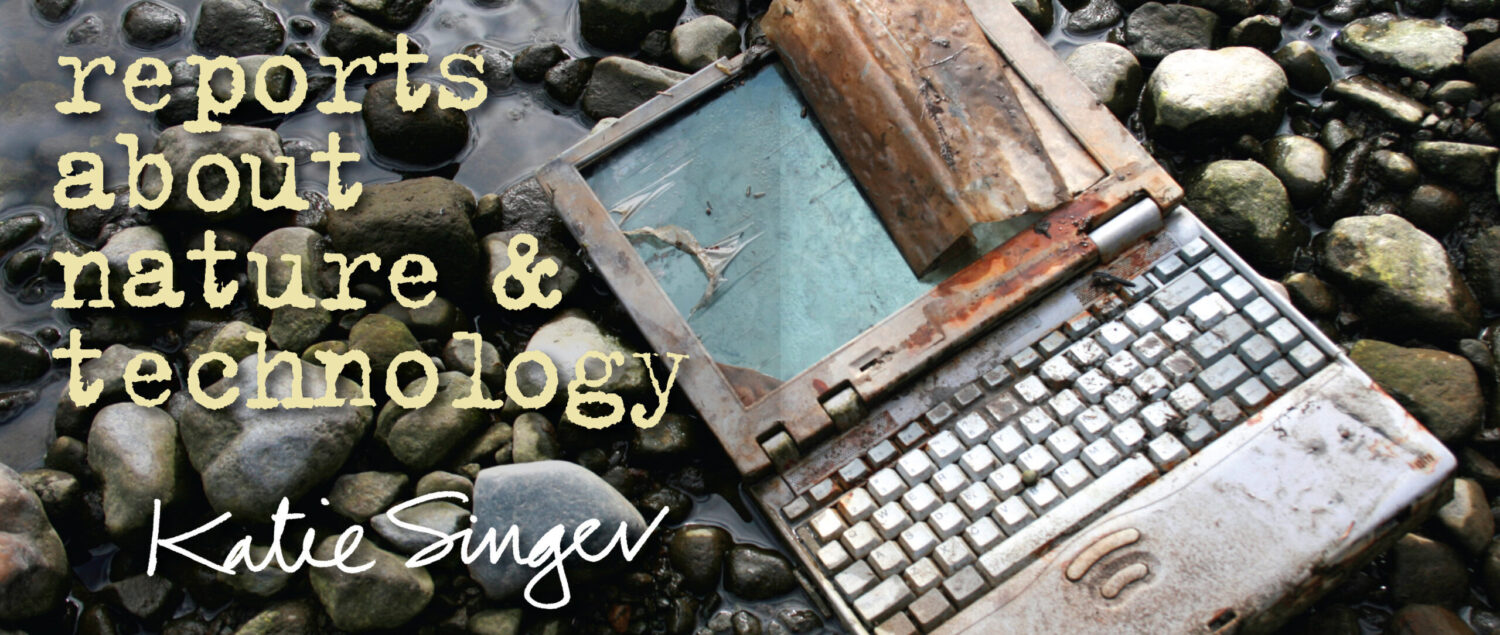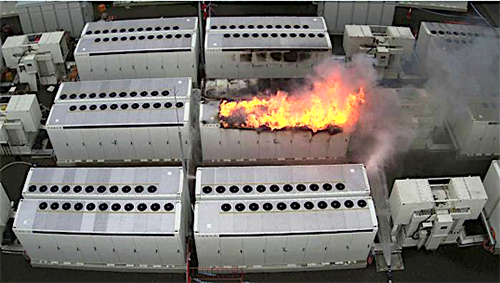Fresh questions about solar power
by Katie Singer * updated September 28, 2022

A field of destroyed solar panels after a storm in St. Thomas, U.S. Virgin Islands, 2017. Photo by Jocelyn Augustino, FEMA
Say that a restaurant offers “healthy, natural” chicken soup. How do you know what it means by “healthy” or “natural?” Farmers can cage chickens, feed them genetically-modified soy, wash butchered birds in antibiotics—and still call their chickens natural. Cooks can use lead-coated pots1 and chemically-fertilized vegetables–and still, legally, call the soup healthy.
“Healthy” and “natural” are marketing terms.
Likewise, when corporations offer “clean,” “renewable” solar photovoltaic (PV) power, how do you know their definition of “clean” or “renewable?”
Now, with The Inflation Reduction Act granting $369 billion to subsidize “renewables” like rooftop and utility-scale solar, must consumers considering these systems assess the technology themselves? Do we aim for an energy resilient country—or just lower electric bills in some households?
When I realized that I don’t know how to live without electricity for more than a few days, I challenged myself to investigate my assumptions about “green” technologies. In this article, I’ll introduce what I’ve learned about solar photovoltaics (PVs).
Assessing electronics from design to discard
Accurate assessment of any product, including solar PVs, requires analyzing impacts from manufacturing, operation and discard. Energy used to manufacture any electronic product accounts for much more than what it uses during operation and discard. For example, a laptop consumes 81% of lifetime energy use before its end-user turns it on for the first time.2
Then, energy efficiency actually increases consumption: when a product’s efficiency increases, its price decreases, and more people buy it. This leads to more manufacturing—more energy use, mining and hazardous waste.3
#1 Manufacturing
You know those white squares under solar panels’ glass? They’re made from pure silicon, which is not available in nature. Manufacturing polysilicon starts with transporting pure quartz gravel, a pure carbon (i.e., petroleum coke) and moist wood to a smelter that is kept at 3000 degrees Fahrenheit for years at a time. Smelters require steady delivery of electricity—or they could explode. They’re typically powered by natural gas, coal and/or nuclear power. Neither solar nor wind can power a smelter since they provide only intermittent power.4
For Step 2, producing polysilicon, a modern factory consumes up to 400 megawatts of continuous power per year. Producing 20,000 tons of polysilicon draws enough power for 300,000 homes.5
Next—making a cylindrical silicon ingot, then slicing it into wafers—are also energy-intensive, toxic waste-emitting processes.6
Nearly half the world’s polysilicon comes from a handful of Chinese factories. Reports claim that these manufacturers use forced Uyghur labor.7,8
Once silicon is formed, phosphorous, boron and sometimes arsenic are “doped” into it so wafers can receive electric signals.
To increase durability, dirt-repellency and energy production, a solar panel’s frame, front sheet, back sheet and encapsulant9-13 (and batteries, if there are any14,15) each, typically, hold perfluorinated chemicals (PFAs). Exposure to “forever chemicals” may weaken immune systems, increase cholesterol levels, change liver enzymes, increase pregnant women’s risks of high blood pressure, and increase kidney or testicular cancer risks.16-18 While manufacturers claim that newer PFAS are safer, research shows that these chemicals are equally harmful.19 If panels crack (from hailstorms, say), do PFAs leach into groundwater?20,21
Can manufacturers verify that their solar panels do not include PFAs?
Transporting solar PVs’ raw materials to factories—and final products to consumers—requires cargo ships powered by highly polluting bunker fuel. 22
#2 Operation
On sunny days in North America, solar PVs collect sunlight and generate energy between about 11am and 3pm. On cloudy days, they produce 10-25% of sunny-day energy. Meanwhile, households demand electricity mostly around dinnertime. Users who want electricity 24/7 therefore need backup power.
Ten percent of solar systems are backed up by battery storage. Making batteries requires mining (i.e., lithium, cobalt, copper), chemicals and water. Batteries are hazardous to manufacture and at disposal.23
About ninety percent of solar PV systems stay grid-connected. Their backup comes from whatever fuel the utility uses.
Solar PVs can weaken grid stability. For example, grid-connected solar systems generate so much daytime electricity that utilities must sometimes pay other utilities to take their excess.24
#3 End-of-life waste
While the vast majority of toxic waste occurs during manufacturing, by the end of 2016, the world had generated about 250,000 metric tons of discarded solar panels. By 2050, the world could acquire 78 million metric tons of (hazardous) solar panel waste.25,26
Typically, solar panels contain lead, cadmium and toxins like PFAs. Since modules can break—and toxins can leach into soil—solar panels should not be disposed of in “regular” landfills.27,28 Recycling solar panels requires separating their materials—and consumes substantial energy.
Fire hazards
A solar PV system is an electrical system. All electrical systems pose fire hazards. For example,
- a rooftop solar system requires wiring multiple panels together, connecting them to the main power system, and a DC-to-AC inverter. Whenever electrical connections increase, so do fire hazards.
- Because many components in a solar system are outdoors,29 hazards increase again. If PVC tubing on solar systems is made from soy, rodents may chew on it and expose wires—which could lead to arcing. Can manufacturers verify that their PVC tubing does not include soy?
- Even if they have special training, firefighters may not be able to stop fight solar PV fires directly.30 If there’s a fire while panels generate electricity, can firefighters turn panels off?
- An August, 2022 lithium-ion battery fire at Australia’s Victorian Big Battery projectBattery Electric Storage Systems (BESS), which store power generated by solar PVs,31 also pose fire and toxic chemical hazards.32 On September 20, 2022, a Tesla mega pack battery (one of 256) caught fire at PG&E’s battery storage facility in Moss Landing, California.33,34 Nearby residents were told to shelter-in-place, close windows and ventilation systems—because when lithium-ion batteries burn, they emit hazardous chemicals.35 For most of a day, businesses and storefronts were not allowed to open; roads in the Monterey Bay area were closed. Designed and maintained by PG&E and Tesla, this BESS plant could store enough energy (generated by solar PVs) to power 225,000 homes for up to four hours during peak demand. This was the facility’s third fire since it opened in April. For now, it is shut down indefinitely. For a list of BESS plants that have caught fire, visit: https://storagewiki.epri.com/index.php/BESS_Failure_Event_Database.
When asked at a February, 2019 public hearing (while the Spotsylvania County Board of Supervisors considered sPower’s permit request for its 500 MW, 1.6 million panel facility) how he would fight a fire at the facility (which does not have battery storage), County Fire Chief Jay Cullinan said he would likely set up a defensive perimeter and deploy his assets to nearby, threatened residential areas. He would avoid sending his firefighters into the actual solar facility to fight the fire unless it was small.
If a corporation proposes a utility-scale solar facility near you, could your county require it to provide a professional engineer (PE)’s report certifying that they have evaluated the proposed plant and determined that all fire hazards have been mitigated?

On large fields, solar panels disrupt natural relationships between water, soil, vegetation and carbon.
Other key issues:
- Since solar PVs produce low-energy-density, large arrays require massive amounts of acreage to supply industries with sufficient power. For example, Virginia’s 500MW Spotsylvania Energy Facility removed 4500 acres of trees before installing 1.6 million solar panels to power data centers (with backup from the nearby natural gas-powered utility).36 Could individuals and municipalities analyze the cost v. benefit of the entire system (to include the carbon, energy and extractions embedded in manufacturing) as well as the ecological footprint of manufacturing, operating and discarding the solar PV system before replacing other energy sources with solar PVs.
- When converting the sun’s direct current to alternating current, solar PV systems expose residents to potentially harmful electrical pollution.37
- Manufacturing solar PV systems depends on rare earths. China controls 70% of the rare-earth market: dependence on it creates geo-political conflicts.38
- While demand grows for solar PVs and other electronics, so does demand for cobalt, nickel, manganese and copper. Mining these ores endangers fragile ecosystems including the Amazon.39 As terrestrial supplies become harder and less profitable to extract, some propose mining the ocean floor, regardless its impacts to marine ecology.40
- Demand for copper—used in solar panel wiring, cables and inverters—could exceed supply by 2025.41
New questions and challenges
Proponents might say that solar PV systems emit less greenhouse gases than fossil fuels. Whether or not this is true, don’t we need to reduce all kinds of ecological harm? In 2016, The United Nations’ Environmental Programme noted that countries that invest heavily in “green” technologies—Sweden, Germany and the U.S.—rank sustainable on the UN’s index.42 China, the Democratic Republic of Congo and India—where ores are mined and smelted, where manufacturers make chemicals and dope silicon, where e-waste is discarded—these countries generate CO2, toxic waste and worker hazards—and rank unsustainable.
Instead of comparing fossil fuels and solar PVs, could we focus on reducing international production and consumption?
Could we restore the engineering principle that no technology is safe or ecologically sound until licensed experts prove it?
Could we define and monitor terms like “sustainable,” “carbon-neutral,” “zero-emitting” and “renewable?”
Would consumers research the supply chain of one substance in a solar panel, a smartphone, a TV or an e-vehicle—and host forums to share their research with classmates, neighbors and co-workers?
Could households, schools, businesses and municipalities each reduce their consumption by three percent each month—and share what they learn?
Systemically and by household, how could we reduce consumption by three percent each month?
Study and discuss what safe, reliable, affordable electricity require. (Is ecologically sound electricity possible?)43
Learn from countries prone to frequent blackouts.
Paint rooftops with reflective paint.
Opt for swamp coolers over air conditioners.
Dry laundry in the sun.
Build and cook with solar ovens.
Grow food at schools, businesses, clinics and in neighborhoods.
Compost kitchen scraps.
Walk, bike or take public transportation.
Create media diets. Wait at least four years to upgrade new hardware and software. Prefer wired connections (which use much less energy) to mobile ones. For meetings, prefer voice (which uses much less data and energy) to video. Delay electronics for children at least until they master reading, writing and math on paper. Download videos rather than stream them. Limit video-watching to (say) three hours per week.
Since buying anything new engages the global super-factory, keep what we have in good repair. Celebrate mechanics and people who consume less.
Live with the questions: What’s a luxury? What’s essential? and treasure people who will discuss them.
References
-
-
- www.tamararubin.com
- https://spectrum.ieee.org/energy/environment/your-phone-costs-energyeven-before-you-turn-it-on
- Read about the Jevons Paradox, first described in William Jevons’ 1862 book, The Coal Question.
- Troszak, Thomas, “The hidden costs of solar photovoltaic power,” NATO Energy Security Centre of Excellence, No. 16., Nov. 2021. https://www.enseccoe.org/data/public/uploads/2021/11/d1_energy-highlights-no.16.pdf
- Bruns, Adam, “Wacker Completes Dynamic Trio of Billion-Dollar Projects in Tennessee: ‘Project Bond’ cements the state’s clean energy leadership,” 2009, www.siteselection.com
- Troszak, Thomas, “Why Do We Burn Coal and Trees for Solar Panels?” https://www.researchgate.net/publication/335083312_Why_do_we_burn_coal_and_trees_to_make_solar_panels
- Murtaugh, Dan, Colum Murphy and James Mayger, “Secrecy and Abuse Claims Haunt China’s Solar Factories in Xinjiang, April 13, 2021. https://www.bloomberg.com/graphics/2021-xinjiang-solar/
- Bloomberg News, “Solar energy boom could worsen forced labor in China, group says,” March 28, 2022.
- Rojello Fernandez, Seth, C. Kwiatkowski, T. Bruton, “Building a Better World: Eliminating Unnecessary PFAS in Building Materials,” Green Science Policy Institute, 2021. https://greensciencepolicy.org/docs/pfas-building-materials-2021.pdf
- AiT Technology. (2015). Transparent Encapsulating PVDF Front Sheet – AI Technology, Inc. AiT Technology.
https://www.aitechnology.com/products/solar/transparent-pvdf-encapsulating-front-sheet/?s= - Terreau, C., De, J., & Jenkins, S. (2014). Encapsulation of solar cells (USPTO Patent). Google Patents.
https://patentimages.storage.googleapis.com/80/c1/43/c47454f302f6d6/US8847063.pdf - Daikin. (2020a). Chemical Products UNIDYNE Repellents and Surface Modifiers Daikin America. Daikin America.
https://daikin-america.com/surface-modification-technology/#zeff - Daikin. (2020b). Renewable Green Energy Zero-Energy Fluoropolymers. Daikin America. https://daikin-america.com/renewable-energy/
- Arcella, V., Merlo, L., Pieri, R., Toniolo, P., Triulzi, F., & Apostolo, M. (2014). Fluoropolymers for Sustainable Energy. In D. Smith, S. Iacono, & S. Iyer (Eds.), Handbook of Fluoropolymer Science and Technology (pp. 393–412). Wiley Online Library. https://doi.org/10.1002/9781118850220
- Daikin. (2012). Business Review: Daikin Fluorochemical Products. In Chemwinfo. http://www.chemwinfo.com/private_folder/Uploadfiles2015_Feb/Daikin_Brochures_Chem_Biz.pdf
- Agency for Toxic Substances & Disease Registry. (2018). ATSDR – Toxicological Profile: Perfluoroalkyls. Agency for Toxic Substances & Disease Registry. https://www.atsdr.cdc.gov/ToxProfiles/tp200.pdf
- C8 Science Panel. (2012). C8 Probable Link Reports. C8 Science Panel. http://www.c8sciencepanel.org/prob_link.html
- National Toxicology Program. (2016). NTP Monograph Immunotoxicity Associated with Exposure to Perfluorooctanoic Acid or Perfluorooctane
Sulfonate. In the National Toxicology Program. https://ntp.niehs.nih.gov/ntp/ohat/pfoa_pfos/pfoa_pfosmonograph_508.pdf - Gomis, M. I., Vestergren, R., Borg, D., & Cousins, I. T. (2018). Comparing the toxic potency in vivo of long chain perfluoroalkyl acids and fluorinated alternatives. Environment International, 113, 1–9. https://doi.org/10.1016/j.envint.2018.01.011
- http://www.basinandrangewatch.org/DesertSunlight.html
- http://www.businessnorth.com/daily_briefing/storm-damages-minnesota-power-solar-power-plant/article_a7f34d54-75fb-11e6-89fe-53abb52280c3.html
- https://www.wired.com/story/container-ships-use-super-dirty-fuel-that-needs-to-change/
- Klinger, PhD, Julie Michelle, “Environmental Footprints of Rare Earth Mining Past and Present,” Center for the Sustainable Separation of Metals, Feb. 23, 2021. https://www.youtube.com/watch?v=DGQeXrkCqM0
- Penn, Ivan, “California invested heavily in solar power. Now there’s so much that other states are sometimes paid to take it,” LA Times, June 22, 2017.
- https://www.irena.org/publications/2016/Jun/End-of-life-management-Solar-Photovoltaic-Panels
- Atasu, Atalay, et al., “The Dark Side of Solar Power,” Harvard Business Review, June 18, 2021. https://hbr.org/2021/06/the-dark-side-of-solar-power
- https://www.re-plus.com/wp-content/uploads/2016/09/N253_9-14-1530.pdf
- Kisela, Rachel, “California went big on rooftop solar. Now that’s a problem for landfills, LA Times, July 14, 2022. https://darik.news/california/californias-growing-solar-panel-waste-poses-environmental-risk-due-to-lack-of-safe-disposal-options-affect-your-world-today/657021.html
- https://www.digikey.com/en/articles/system-wiring-and-interconnect-for-rooftop-solar-panels
- Piantedosi, Matt and Tony Granato, “Solar PV Fire Safety Training,” U.S. Dept. of Energy SunShot Initiative Rooftop Solar Challenge II. https://www.cesa.org/wp-content/uploads/CESA-PV-Fire-Safety-Training-Slides.pdf
- https://www.utilitydive.com/spons/energy-storage-101-how-energy-storage-works/627194/
- https://rivercitymalone.com/wind-solar-energy/bess-bombs-part-1/ https://rivercitymalone.com/wind-solar-energy/bess-bombs-part-2/
- Copitch, Josh, “Highway 1reopened near Moss Landing, shelter-in-place lifted,” KWBW Action news, Sept. 21, 2022. https://www.ksbw.com/article/highway-1-reopened-near-moss-landing-shelter-in-place-lifted/41302918
- Wright, Thomas, Sept. 20, 2022, Monterey County Herald. https://www.santacruzsentinel.com/2022/09/20/caltrans-highway-1-temporarily-closed-in-moss-landing/ https://www.nature.com/articles/s41598-017-09784-z.pdf
- Larsson, Fredrik, et al, “Toxic fluoride gas emissions from lithium-ion battery fires,” Scientific Reports, 30 August 2017.
- Johnson, Jeromy, “The Dark Side of Solar,” April 2017. https://www.emfanalysis.com/wp-content/uploads/2017/04/Dark-Side-of-Solar.pdf
- https://smallcaps.com.au/rare-earth-stocks-asx/ultimate-guide/ Cullinane, Danica, “Rare earth stocks on the ASX: The Ultimate Guide,” September 11, 2019.
- www.OurWeb.tech/letter-28
- Aldred, Jessica, “Explainer: Deep-sea mining,” China Dialogue, 11.23.21. https://chinadialogueocean.net/6677-deep-seabed-mining/; Teske S, Florin N, Dominish E, Giurco D., “Renewable Energy and Deep Sea Mining: Supply, Demand and Scenarios: Report prepared by ISF for J.M.Kaplan Fund, Oceans 5 and Synchronicity Earth,” July 2016; 2016.
- https://www.mining.com/the-looming-copper-crunch-and-why-recycling-cant-fix-it/
- Jason Hickel, “The World’s Sustainable Development Goals Aren’t Sustainable,” Sept. 30, 2020. https://foreignpolicy.com/2020/09/30/the-worlds-sustainable-development-goals-arent-sustainable/ Global Material Flows and Resource Productivity: Assessment Report for the UNEP International Resource Panel, 2016. https://www.resourcepanel.org/reports/global-material-flows-and-resource-productivity-database-link
- www.OurWeb.tech/letter-14
-
Further Resources
Citizens for responsible solar: https://www.citizensforresponsiblesolar.org/
Jensen, Derrick, Lierre Keith and Max Wilbert, Bright Green Lies: How the Environmental Movement Lost Its Way and What We Can Do About It, Monkfish, 2021.
Martin, PhD., Calvin Luther, “Solar Energy: Yes or No?” https://d19cgyi5s8w5eh.cloudfront.net/usr/7cf0b55423c99874f014fa1484465c9c/eml/0gT1mQ6MSLyoWNirz_1NKw?e=19clay%40gmail.com&a=GZmXcm4zQ6GbJD1RJ2k-iQ&f=&t=
Owen, David, The Conundrum: How Scientific Innovation, Increased Efficiency, and Good Intentions Can Make Our Energy and Climate Problems Worse, Riverhead, 2011.
Rehbein, Jose A., et al., “Renewable energy development threatens many globally important biodiversity areas,” Global Change Biology, 4 March, 2020.
Smith, Olivia, “The dark side of the sun: avoiding conflict over solar energy’s land and water demands,” New Security Beat, 10.2.18. https://www.newsecuritybeat.org/2018/10/dark-side-sun-avoiding-conflict-solar-energys-land-water-demands/
Deep-sea mining (for materials that make electronics, solar PVs, and e-vehicles possible) now steps further toward a green light. https://www.theguardian.com/world/2022/aug/27/united-nations-ocean-treaty-marine-life
Documentaries:
-
-
- Jeff Gibbs’ and Michael Moore’s “Planet of the Humans”
- Julia Barnes’ “Bright Green Lies”
- Jean-Louis Perez and Guillaume Pitron’s “The Price of Green Energy”
-
Katie Singer writes about the energy, extractions, toxic waste and greenhouse gases involved in manufacturing computers, telecom infrastructure, electric vehicles and other electronic technologies. She believes that if she’s not aware that she’s part of the problem, then she can’t be part of the solution. She dreams that every smartphone user learns about the supply chain of one substance (of 1000+) in a smartphone. Her most recent book is An Electronic Silent Spring. She currently writes about nature, democracy and technology for Meer.com. Visit www.OurWeb.tech and www.ElectronicSilentSpring.com.
This article was originally published by Meer.com.

